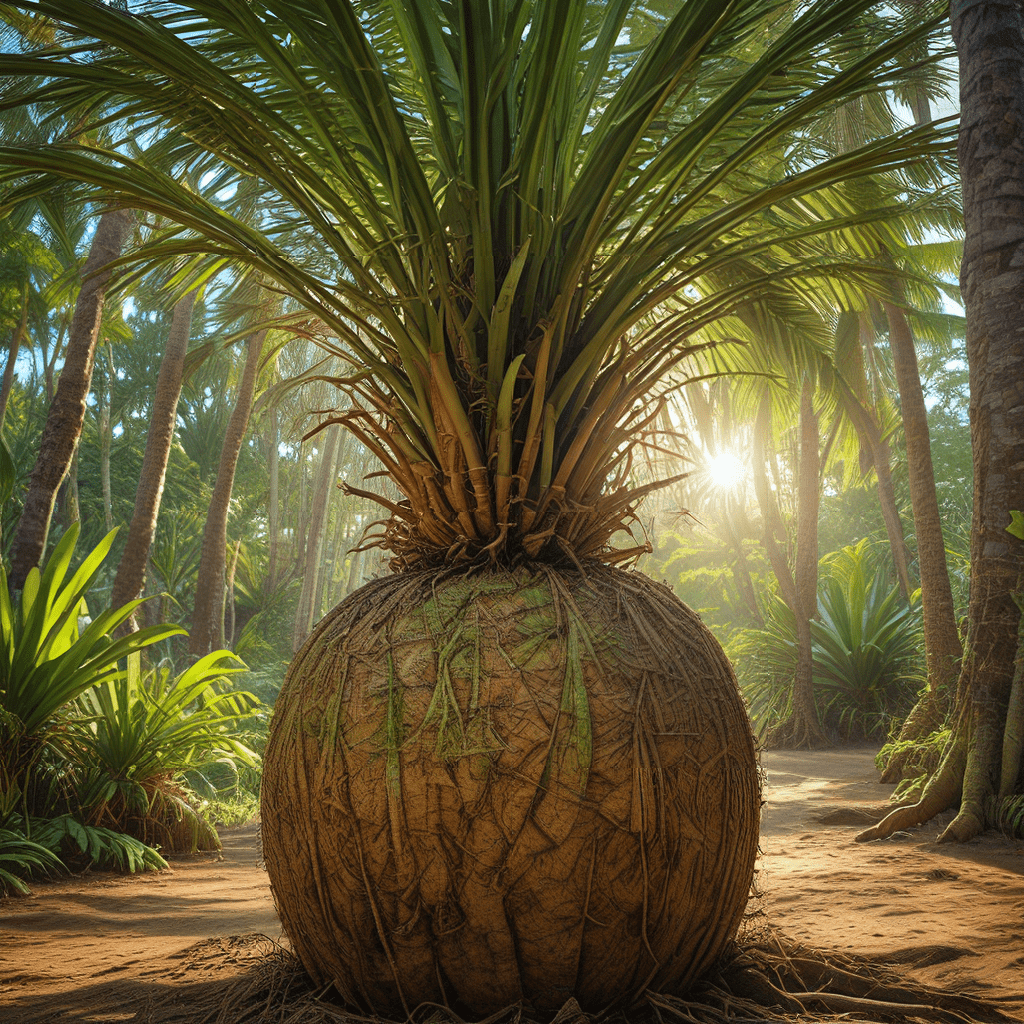The Lauhala Tree: A Symbol of Strength and Resilience
In the vibrant tapestry of Hawaiian culture, the lau hala tree (Pandanus tectorius) stands tall as a testament to the resilience and adaptability of the islands' people. More than just a plant, the lauhala is a deeply revered symbol that represents strength, resilience, and the interconnectedness of all things. This iconic tree has played a vital role in Hawaiian life for centuries, providing sustenance, shelter, and the materials for countless traditional crafts.
The lauhala tree is a symbol of strength and resilience for many reasons. It thrives in harsh coastal environments, weathering strong winds, salty air, and unpredictable weather patterns. Its extensive root system anchors it firmly to the ground, allowing it to withstand even the most powerful storms. This steadfastness is mirrored in the Hawaiian people, who have faced numerous challenges throughout their history and have always found ways to adapt and overcome.
Mythology: The Origin of the Lauhala Tree
The lauhala tree holds a special place in Hawaiian mythology and legends, with its origins often linked to the creation of the islands themselves. One popular tale recounts the story of the goddess Hina, who was known for her extraordinary skill in weaving. One day, she was tasked with creating a new island, a challenge met with determination and ingenuity. Hina gathered the leaves and branches of a nearby pandanus tree and wove them together, forming the framework of a new land. This legend embodies the deep connection between the people and the lauhala tree, highlighting its role in shaping the very landscape of the Hawaiian Islands.
Another story tells of Ku, the god of creation, who used the lauhala tree to create the first humans. This myth further emphasizes the importance of the tree in the Hawaiian worldview, associating it with the very origins of life itself.
The Lauhala Tree in Hawaiian Creation Myths
The lauhala tree is woven deeply into various creation myths, highlighting its significant role in Hawaiian cosmology. One of the most prominent tales tells of the origin of the Hawaiian Islands. The story narrates the journey of the demigod Maui, who used his magical fishhook to pull the islands from the ocean depths. As Maui fished, he left a trail of lauhala leaves, which became the foundation for the new land masses. This myth illustrates the lauhala tree's connection with the very birth of the Hawaiian Islands, symbolizing the creation of a life-sustaining environment.
The Hawaiian people believed the lauhala tree to be a powerful symbol of mana, a life force that permeates all things in nature. Its presence was thought to bring good fortune and protection, particularly to those who respected and honored its significance. The tree served as a reminder of the interconnectedness of all living things, emphasizing the importance of maintaining a harmonious relationship with the natural world.
The Lauhala Tree: A Symbol of Adaptation and Resourcefulness
The lauhala tree is a symbol of adaptation and resourcefulness, reflecting the ingenuity of the Hawaiian people. The tree's leaves, known as lau, are incredibly versatile and have been used for a wide range of purposes for centuries. Their resilience and durability make them ideal for weaving baskets, mats, hats, and even sails. The versatility of the lauhala leaf highlights the practical wisdom and environmental awareness of the Hawaiian people, who learned to utilize every part of the tree to meet their needs.
The lauhala tree's ability to thrive in challenging environments, like the rugged Hawaiian coast, exemplifies human resilience in the face of adversity. Its resilience in the face of harsh conditions mirrors the Hawaiian people's ability to adapt and thrive in a dynamic and sometimes unforgiving environment.
The Importance of the Lauhala Tree in Hawaiian Culture
The lauhala tree holds a profound significance in Hawaiian culture, serving as a symbol of tradition, community, and sustainability. Its importance transcends its practical applications, reaching into the very soul of the Hawaiian people. The tree is deeply intertwined with their history, traditions, and even their spiritual beliefs.
The lauhala tree is a reminder of the importance of preserving cultural heritage. The intricate weaving techniques passed down through generations, using lauhala leaves, represent a wealth of knowledge and artistry that connects the present generation to those who came before them. These traditions are not merely nostalgic, but they reflect the wisdom and ingenuity of the Hawaiian people in sustainably utilizing natural resources.
The Lauhala Tree: A Source of Food and Shelter
The lauhala tree provided sustenance and protection for the Hawaiian people for centuries. Its fruits, known as hala, are a nutritious and versatile food source. The ripe hala fruit has a sweet and slightly tart flavor and can be eaten raw, baked, or fermented into a refreshing beverage. The hala fruit is also a source of valuable nutrients, including vitamins, minerals, and fiber. The tree's leaves and roots also offer practical uses for shelter. The strong and flexible leaves can be woven into sturdy mats, which served as bedding, flooring, and even roofing materials. The extensive root system of the lauhala tree provided a natural anchor for homes and structures, offering a secure foundation in the unpredictable Hawaiian climate.
The Lauhala Tree: A Material for Traditional Crafts
The versatility of the lauhala leaves made them a prized material for traditional Hawaiian crafts. The leaves were carefully dried and woven into a wide range of items, showcasing the artistry and resourcefulness of the Hawaiian people. Lauhala mats, known as "papaʻu," were used for a variety of purposes, from sleeping mats to ceremonial coverings. The Hawaiian people also used lauhala leaves to weave baskets, hats, bags, fans, and even sails for canoes. These intricate crafts reflected the unique cultural heritage of the islands, and they were often adorned with intricate patterns and designs that held symbolic meaning. The lauhala tree, with its abundant and versatile leaves, fostered a vibrant tradition of craftsmanship that continues to this day.
The Lauhala Tree: A Symbol of Community and Togetherness
The lauhala tree played a central role in fostering community and togetherness among the Hawaiian people. The process of harvesting the leaves and weaving them into crafts was often a communal activity, bringing people together to share knowledge, stories, and laughter. The lauhala tree's abundance provided a shared resource that fostered a sense of interconnectedness and mutual support. The act of weaving lauhala together into intricate patterns symbolized the strength and resilience of the community, a testament to the interconnectedness of all things. The lauhala tree served as a tangible reminder of the shared history and cultural heritage that united the Hawaiian people.
The Lauhala Tree: A Reminder of the Importance of Sustainability
The lauhala tree stands as a beacon of sustainability, reminding us of the importance of respecting and conserving our natural resources. The Hawaiian people developed a deep understanding of the tree's life cycle and its role within the ecosystem. They practiced sustainable harvesting methods, ensuring that the lauhala tree would continue to thrive for future generations. The lauhala tree teaches us the importance of living in harmony with nature, taking only what we need and giving back with respect and care. Its resilience and adaptability serve as a reminder that our relationship with the natural world is one of interdependence, requiring a balance between our needs and the well-being of the environment.
The Lauhala Tree: A Source of Inspiration for Modern Hawaiians
The lauhala tree continues to inspire and influence modern Hawaiians. Its symbolic resonance and enduring legacy have sparked a renewed appreciation for traditional Hawaiian culture and the importance of preserving cultural heritage. Contemporary artists, artisans, and designers are drawing inspiration from the lauhala tree, incorporating its aesthetic and symbolic qualities into their work. The lauhala tree's versatility and strength serve as a reminder that even in a rapidly changing world, the lessons of resilience, adaptability, and community remain timeless.
FAQ
Q: What is the scientific name for the lauhala tree?
A: The scientific name for the lauhala tree is Pandanus tectorius.
Q: Where is the lauhala tree found?
A: The lauhala tree is native to tropical regions throughout the Pacific Ocean, including Hawaii, the Philippines, and Southeast Asia.
Q: What are some of the uses of lauhala leaves?
A: Lauhala leaves are used to make a wide range of items, including mats, baskets, hats, bags, fans, and even sails.
Q: How does the lauhala tree symbolize strength and resilience?
A: The lauhala tree thrives in harsh coastal environments, weathering strong winds and salty air. Its extensive root system anchors it firmly to the ground, allowing it to withstand even the most powerful storms. This steadfastness is mirrored in the Hawaiian people, who have faced numerous challenges throughout their history and have always found ways to adapt and overcome.
Q: What is the significance of the lauhala tree in Hawaiian mythology?
A: The lauhala tree holds a special place in Hawaiian mythology, with its origins often linked to the creation of the islands themselves. One popular tale recounts the story of the goddess Hina, who was known for her extraordinary skill in weaving. One day, she was tasked with creating a new island, a challenge met with determination and ingenuity. Hina gathered the leaves and branches of a nearby pandanus tree and wove them together, forming the framework of a new land. This legend embodies the deep connection between the people and the lauhala tree, highlighting its role in shaping the very landscape of the Hawaiian Islands.



